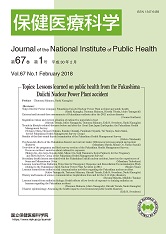Although Japanese patients have suffered various hardships and miseries, they have fought to improve their conditions and won the rights that they rightfully deserve. This paper aims to provide an overview of the history of what has been done for and by patients in Japan.
During a cholera pandemic in the latter half of the 19th century, patients with cholera were quarantined in facilities for evacuating people from disease (“Hibyoin”) and left untreated. With industrialization, tuberculosis became prevalent among the poor, especially among female factory workers around the 1900s; however, adequate treatment was lacking due to a shortage of sanatoria. Sexually transmitted diseases (STDs) were defined as “Karyu-byo,” which are diseases transmitted by geishas and prostitutes. Women have endured two tragedies: one as prostitutes and the other as wives, as a result of Karyu-byo spreading across society through prostitutes to men, and from those men to their wives. From the beginning of the 20th century, patients with leprosy wandering around towns and rural villages were admitted to leprosaria. This treatment was later extended to include all patients, and subsequently, a national policy was enacted to admit all patients with leprosy to leprosaria and to completely isolate them for life. Patients in leprosaria were subjected to imprisonment, reduced diet, confinement, reprimands, and other punishments, were forced to perform “work by the patient,” such as cleaning, laundry, and nursing care for patients with severe conditions, and were occasionally subjected to vasectomy. The early 1900s saw many patients with mental disorders being detained in private homes, which encouraged the establishment of psychiatric hospitals. In psychiatric hospitals, many instruments (handcuffs, shackles, chains, etc.) were used for patients who were out of control. Subsequently, custody in private homes was prohibited, and a system of involuntary hospitalization was established, whereby an individual with mental disorders who presents a risk of harming him/herself or others may be hospitalized in a psychiatric hospital.
In addition to patients with the diseases described above, those with pollution-related diseases, occupational diseases, iatrogenic diseases, rare and intractable diseases, acquired immunodeficiency syndrome (AIDS), and COVID-19 were also subjected to discrimination. In addition, there was a system called “patients for medical use,” in which poor patients were utilized for research and education.
After World War II, patients began to actively appeal to society to address their demands and issues, and this trend developed into the patients’ advocacy movement, which is said to be unique in the world. Patient associations were initially organized by patients in sanatoria and leprosaria. Since the 1950s, patient associations have been established for various diseases, including rare and intractable diseases, pollution-related diseases, etc. In the 1970s, various patient associations that had been established for each disease began to align with one another, and finally, the Japan Patients Association (JPA) was established in May 2005, as a unified body of patient associations.
The protection of the human rights of patients and the assurance of their livelihood and medical care are now explicitly stated in legislation. However, it has not yet been possible to elucidate the causes of the disease and to establish treatment methods that are specifically required by patients with rare and intractable diseases. To promote research and development, patients should be aggressively involved from the perspective of patient and public involvement (PPI).
View full abstract
